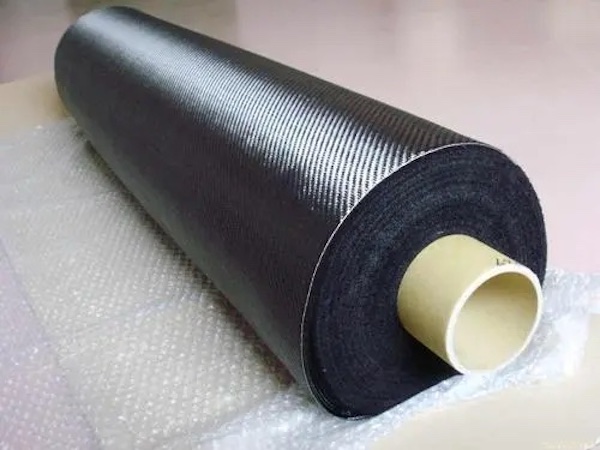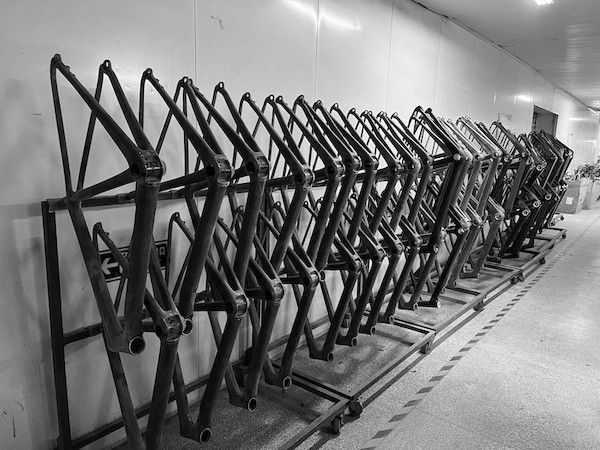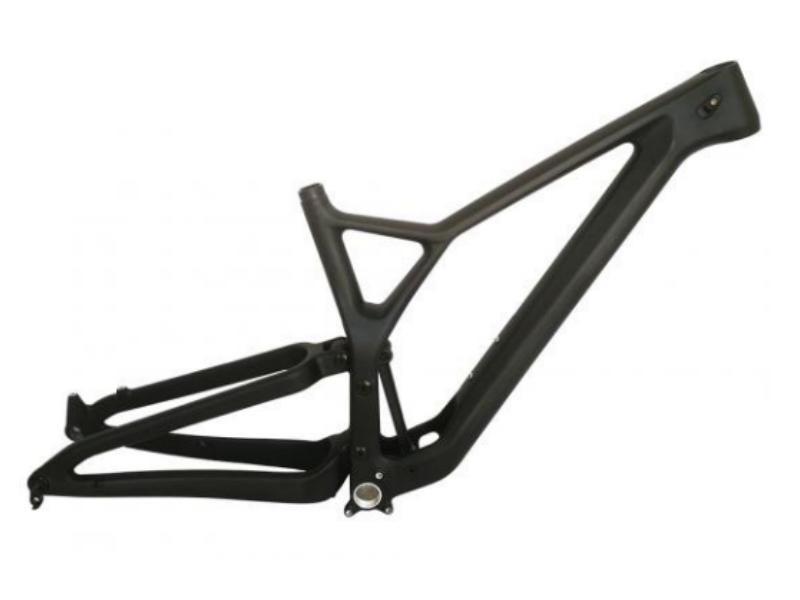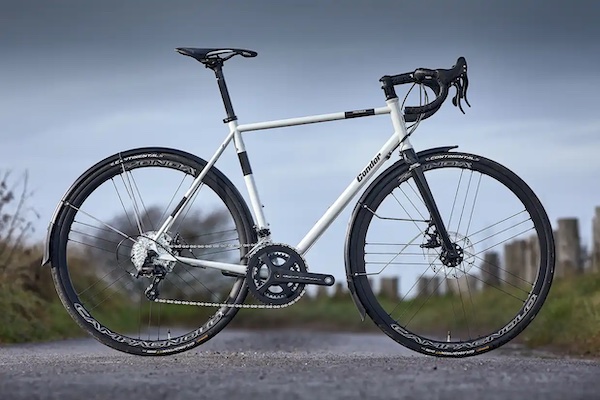Categories
New Blog
Tags

The frame is the soul of the bicycle. Normally,Bike frames are made of carbon fiber, aluminum, steel, or titanium. The majority of bikes frames are made of either carbon fiber or aluminum. When it comes to choosing a frame, one of the most important considerations is the material. This guide will explain the pros and cons of carbon vs aluminum bike frames. We’ll compare the weight, durability, handling, efficiency, comfort, cost, longevity, and more to help you decide which frame material is best for your next bike.
Carbon fiber is basically a plastic that is reinforced with super strong fibers. It offers an incredibly high strength to weight ratio. It is also extremely rigid.This material is shaped into bike frames using molds and heat.
There is a lot of variation in the way that carbon frames are built as well as the way the carbon fiber itself is made. For example, the type of resin used, the thickness of the layers, the construction style, the way the material is heated, the direction of the fibers, the grade of carbon fiber, and the density and types of fibers used all play a role in the ride characteristics, durability, stiffness, and comfort of the finished frame.
Aluminum Bike Frames
Before carbon fiber became affordable and accessible to cyclists, aluminum was the most common frame material. The material is lightweight, stiff, affordable, and easy to work with.
Aluminum itself isn’t strong enough for building bike frames. It must be alloyed with other metallic elements, like magnesium, zinc, or silicon, to increase the strength and durability.

Carbon Fiber Bike Frames: Pros and Cons
Pros
1)Lighter weight because the material is stronger and less dense
2)Stiffer and more responsive. This improves handling
3)More comfortable/better ride quality
4)Carbon frames can last longer because they don’t fatigue
5)Carbon fiber frames can be repaired if they crack
6)More efficient because they are lighter, more aerodynamic, and more rigid
7)No corrosion
8)Higher-end and more technologically advanced
Cons
1)More expensive
2)Durability can be an issue. Carbon frames can crack from a light impact in some cases. You can also accidentally crack a frame by overtightening components
3)Harder to carry luggage because you can’t mount racks and panniers to most carbon frames
4)Bad for the environment because carbon fiber is not very recyclable
5)Safety can be an issue because carbon frames can fail without warning if they are compromised
Aluminum Bike Frames: Pros and Cons
Pros
1)Cheaper
2)More durable. Aluminum can withstand a harder impact without cracking or failing because it is less brittle
3)More environmentally friendly. Aluminum is highly recyclable
4)You can mount luggage and use your frame for touring
5)Safer because aluminum is less likely to fail unexpectedly
Cons
1)Harsher ride because the frame is more rigid
2)Heavier
3)Aluminum frames often can’t be repaired if they crack
4)Aluminum frames don’t last as long because the metal fatigues over time
Carbon Fiber Vs Aluminum Bike Frames
While both materials can be made into responsive, comfortable, and lightweight frames, they each have some strengths and weaknesses. In this section, we’ll compare carbon fiber and aluminum bike frames.

Carbon fiber bike frames are lighter than equivalent aluminum frames. In fact, carbon fiber is the lightest bike frame material in use today. A lighter bike allows you to climb and accelerate faster and maneuver more easily because there is less weight to move around.
Many manufactures offer complete 15 lb (6.8 kg) carbon road bikes. This is the minimum bike weight according to the UCI rules. Carbon frames themselves weighs as little as 700-1000 grams. 20 lb complete carbon mountain bikes are commonly available as well.
Complete aluminum road bikes, on the other hand, weigh around 18 pounds on average. That’s 3 pounds heavier. Top of the line aluminum frames weigh about a half of a pound more than carbon frames. Aluminum mountain bike frames weigh around 1 pound more than comparable carbon frames.
Carbon fiber frames are lighter than aluminum frames because the material is less dense. The density of modern carbon fiber is about 1.9 g/cm^3 compared to aluminum which has a density of about 2.3 g/cm^3. Carbon fiber has an incredibly high strength to weight ratio.
Of course, carbon fiber bikes aren’t always the lighter option. Different grades of carbon fiber exist. Lower-end carbon fiber frames use fillers and more resin. This lowers costs but increases the weight. Modern aluminum frames are competitively light. In fact, a low-end carbon frame could weight more than a high-end aluminum frame.
Because both frame materials are so light, the weight of the components also plays a major role. An ultralight carbon frame fitted with heavy, low-end components might end up weighing more and performing worse than an aluminum frame fitted with high-end components. In this scenario, both bikes might end up costing the same.
For most riders, the weight difference is pretty insignificant. In fact, most of us could stand to lose the extra 1-3 pound difference between the frame materials. This would provide better performance gains and cost thousands of dollars less than buying a lighter bike.
Carbon frames offer a more comfortable ride than aluminum frames. The reason is that the material does a better job of absorbing shocks and dampening vibrations from the road.
Generally, you want your frame to be stiff laterally so you don’t waste energy flexing the frame from side to side as you push down on the pedals. Vertically, you want some flexibility for shock and vibration absorption. This makes the ride more comfortable while riding over bumps or rough roads.
Manufacturers can engineer carbon fiber frames in a way that makes them stiff in some places and somewhat flexible in other places. This is possible because carbon fiber can be fine tuned much more than aluminum. Manufacturers can varying the thickness of the carbon fiber, direction of the fibers, use different types of resin and filaments, and more.
Aluminum frames usually have a harsher and less refined ride than carbon frames. Because aluminum is a relatively soft metal, the frame tubes must be fairly thick to make the bike strong and durable. Aluminum frame tubing is thicker than carbon, steel, or titanium frame tubing. This results in an incredibly stiff frame.
Stiff frames make for a harsh ride because the shocks and vibrations from the road transfer straight through the frame to your body. Rigid aluminum frames can’t offer as much dampening as more flexible carbon frames. For this reason, aluminum frames aren’t ideal for off-road riding or long-distance touring.
But aluminum bike frame technology have greatly improved comfort over the past 20 years. The process of hydroforming allows frame builders to vary the thickness of aluminum tubes throughout their length.This process allows manufacturers to form the frame thinner in areas where some flexibility is desired and thicker where strength is needed. The frame can be laterally stiff while still absorbing some vibration. Modern high-end aluminum frames are almost as comfortable as carbon frames.
Because aluminum is a weaker material than carbon fiber, you would expect it to be less durable. In practice, this isn’t the case because aluminum is less brittle. Over the years, aluminum has proven to be an incredibly durable and reliable bike frame material.
Generally, an aluminum frame can handle a harder impact force than a carbon frame without cracking or breaking. The frame may suffer a cosmetic dent but still remain rideable. For this reason, many cyclists who ride in disciplines where crashing is common, like many forms of mountain biking, choose to ride aluminum frames. They can just take more of a beating.
This allows the rider to attempt more challenging trails without having to worry as much about destroying the frame. It’s also easier on the budget. If a frame gets cracked, it’s much cheaper to replace.if you crash hard enough, you can destroy an aluminum frame. If the aluminum cracks, the bike is unsafe to ride because the frame could fail catastrophically without warning. Dents in aluminum can also create weak spots which can compromise the frame. It can be hard to identify whether a dent is a cosmetic or structural issue. If you’re unsure, you’ll want to take the frame to a professional to have it inspected for safety.
Under normal riding conditions, carbon fiber frames are incredibly strong and durable. After all, carbon fiber is 5 times stronger than steel and has one of the highest strength to weight ratios of any material. Problems arise when carbon frames experience a sudden impact force that is concentrated to a small area of the frame.
Because the material is fairly brittle, the frame can crack or break surprisingly easily. A crash hard enough to dent a metal frame could cause a carbon frame to crack, rendering it unrideable. A comparable metal frame may still be rideable after suffering the same impact force.
Historically, carbon fiber hasn’t been the most reliable frame material either. There are plenty of stories out there of carbon frames failing prematurely or cracking during a minor crash. You’ll want to inspect the frame periodically and after an accident.
The most common failure points on carbon frames are the bonded junctions. These are areas where tubes that were made separately during manufacture were stuck together. To be safe, you’ll want to periodically inspect your rear dropouts where the seat and chainstays meet, the head tube where it meets the down tube and top tube, the bottom bracket area, and the area around the seat post clamp.
Areas with glued inserts can also be weak spots. Inspect the bottom bracket threads, headset race, and rear dropouts. You should also look at the bottom of the down tube and chainstays. Rocks get kicked up and can cause damage to the tubes, weakening them. You may want to apply some type of frame protection on these areas.
Cracks can be difficult to spot. It can be helpful to run a cloth along the frame tubes. Broken or lose fibers can catch on the cloth. If you suspect that an area is cracked, you can tap around on it with a coin. A dull sound means the area could be weakened. A crisp sound means the material is in good condition. If you’re unsure, check with a professional.

One of the biggest benefits of carbon fiber frames is that if you crack your frame in an accident or just notice a crack developing from heavy use, it can be repaired in most cases. In fact, carbon fiber frames are often easier to repair than metal frames.
The repair process involves removing the damaged section and recreating that section with new carbon fiber. If the damage is minor, a simple patch can be used.
Carbon frame repair is a job that’s best left to a professional frame builder who knows what they’re doing. DIY repair options are available as well but are only recommended for minor repairs. Bike manufacturers may try to tell you that it’s impossible to repair a broken carbon frame in hopes that you buy a new bike instead. When repaired correctly, the frame is as good as new.
Aluminum frames, on the other hand, can’t be repaired in most cases. The reason is that you can’t simply bend aluminum back into shape and re-weld it like you can with steel. When you weld aluminum, you must re temper or heat treat the whole frame to strengthen the metal. This involves heating then cooling the entire aluminum frame in a controlled manner. This process is more expensive than just buying a new frame. If you skip this step, the weld probably won’t hold.
Also, once a crack or dent has formed in the aluminum tubing, it is difficult to determine the structural integrity of the frame. Another spot could have weakened as well. It’s difficult to tell by looking at the frame. If your aluminum frame cracks, you should replace it.
Tip: Many manufacturers guarantee their frames for a certain amount of time. If your frame cracks, you may be able to get it replaced for free. Be sure to check your warranty before going out and buying a new frame.
Aluminum is the cheapest bike frame material. It’s cheaper than steel, titanium, and carbon fiber. Aluminum frames often cost half as much as carbon frames.
The main reason is that aluminum frames can be mass-produced in a factory. Much of the process can be automated. It takes far fewer man-hours to make an aluminum frame and the raw material is cheaper.The low price is the reason that aluminum frames were introduced in the first place. They brought down the cost of bicycles considerably.
Due to the lower price, aluminum is a popular choice for cycling events that are hard on frames or events where there is a high likelihood of crashing, like downhill or freeride mountain biking. If the frame gets damaged, it is much less expensive to replace.
Carbon frames are more expensive because building them is a labor-intensive process. It takes more man-hours and much of the work must be done by hand instead of a machine. For example, carbon fiber layup must be done by hand. This increases labor costs. Carbon fiber is a difficult material to work with. It takes some skill. Building a carbon frame also requires specialized molds and equipment that add to the cost. The raw material is expensive as well.
To meet a lower price point, some manufacturers use a lower grade of carbon fiber that uses more epoxy and fillers. These frames are heavier and may not offer any benefits over aluminum. If you’re on a tight budget, you’re probably better off staying away from carbon frames or buying used.
Carbon frames are more efficient than aluminum frames. The increased efficiency allows you to travel further using the same amount of energy that you would on a comparable aluminum frame. You’ll probably maintain a higher average speed as well. This is probably the reason that the pros all use carbon frames these days.
Carbon frames are more efficient for three main reasons:
Of course, efficiency really only matters to competitive riders. Recreational riders probably won’t notice a difference or won’t care. The difference is pretty minimal. Both carbon and aluminum can make incredibly lightweight, stiff, and aerodynamic frames.
Frame Longevity: How Long will Carbon and Aluminum Frames Last?
In theory, carbon frames last longer because carbon fiber doesn’t fatigue like aluminum. As long as you take good care of your bike while transporting it and don’t crash too hard, a carbon frame can last indefinitely.Even though carbon fiber is an incredibly strong material, it is more brittle than aluminum. It can’t handle as hard of impacts without cracking. If you participate in a cycling discipline that is particularly demanding on frames, there is a good chance that your carbon frame will crack during an accident and fail prematurely.
Aluminum, on the other hand, fatigues over time. After enough miles, the material eventually cracks and fails. How long your aluminum frame lasts depends on the type of riding you do, how you treat it, and the quality of the aluminum and welds. If you’re hard on your aluminum frame, it may fail after 5 years. If you treat it properly, you could get decades of use out of it.
Safety
Carbon fiber frames may be more dangerous than aluminum frames. The reason is that it isn’t immediately obvious when a carbon fiber frame is structurally compromised. You could miss a hairline fracture during an inspection or the damage could be covered by the frame’s finish. Carbon fiber can fail catastrophically and without warning. Imagine bombing down a hill at 30 mph when your head tube separates from your down tube and top tube.
Aluminum frames don’t fail in the same way. The material tends to give you some early warning signs that it is going to break. The frame may crack and bend slightly before completely failing. You may hear some creaking or notice some changes in the ride quality. It is also easier to spot cracks in aluminum than it is in carbon fiber.
To be safe, you should thoroughly check your bike frame for cracks at least once per season and after a crash. You should do a quick inspection after every wash and if you hear a creak or unfamiliar sound while riding. Be extra through around the common failure points outlined in the durability section above.
To inspect a carbon frame, begin by looking for scratches in the paint. If you spot any scratches that appear deeper than the paint, use a coin to tap around the scratch. Listen for a change in pitch as you tap around the area. If the carbon is broken underneath, the tap will sound dull. You can also gently press on any areas where you suspect that the frame is cracked. If they feel softer, the carbon is broken.
To inspect an aluminum frame, look for any deep dents or cracks on the tubing. Also look closely at the welds to make sure there isn’t any cracking or crimping. Make sure the wheels are aligned. If you find any issues, the frame could be compromised.
Which Frame Material is More Environmentally Friendly? Carbon Fiber or Aluminum
Most cyclists care greatly about the environment. One great feature of aluminum is that is incredibly recyclable. Aluminum frames are much more environmentally friendly than carbon fiber frames.
Unfortunately, carbon fiber is not an environmentally friendly material. The truth is that most of it ends up in landfills. The reason is that carbon fiber is not really recyclable. It can’t be simply melted down and reused like metals.
Corrosion and Degradation
Corrosion isn’t really a concern with either carbon or aluminum frames. This means you don’t have to worry about your frame getting wet or exposed to salty sea air, chemicals, or road salt and rusting. Carbon fiber, not being a metal, doesn’t rust or oxidize at all.
Aluminum alloy contains very little if any iron so it doesn’t rust either. Having said that, aluminum does corrode. Interestingly, corrosion is somewhat beneficial for the material. When aluminum alloy gets exposed to moisture, a hard film of aluminum oxide forms on the surface. This material is quite strong. Much stronger than rust. It also protects the underlying aluminum from further corrosion. This means that an aluminum frame won’t corrode away over time.
Of course, even if the frame can’t corrode, that doesn’t mean that other components can’t as well. You’ll want to keep an eye on your chain, spokes, rims, handlebars, crankset, derailleurs, and any components that contain steel parts. Most bikes also use steel bolts that can corrode over time. If you ride near the ocean, it’s a good idea to keep an eye out for rust. The only bicycle frame material that rusts is steel.
One issue with older or lower-end carbon fiber frames is that UV light could cause them to degrade over time. The carbon fibers themselves do not degrade but the resin used to hold them together could in some cases. This can cause the frame to become brittle and eventually break. This problem has mostly been solved on newer and higher-end carbon fiber frames. If you’re buying a brand new bike, this isn’t even worth worrying about.
Bike Frame Technology, Design, and Optimization
Carbon fiber is a high tech material that gives framebuilders nearly unlimited options for fine tuning and optimizing the frame to their exact desired specifications.Engineers can change the thickness of the carbon fiber with extreme accuracy by varying the number of layers. They can vary the direction of the carbon fiber. Different types of resin can be used in the manufacture of the carbon to change the characteristics of the material. They can vary the density of the carbon filaments or add different fillers to change its characteristics. There are an incredible number of variables that can be adjusted to optimize the bike for performance and comfort.
For this reason, carbon fiber bikes are considered to be higher end. Pretty much every bike being raced professionally in both road and mountain biking is made of carbon fiber. Almost every high-end bike is carbon these days.For some riders, carbon frames are also a bit of a status symbol because they are so expensive.
Even though aluminum is an easier material to work with than carbon fiber, it can’t be manipulated and fine tuned quite as much. Aluminum can be butted and hydroformed to change the shape and thickness of the tubes. Different aluminum alloys are also available with different charactaristics. Some are stiffer than others.
Aluminum is often associated with lower end bikes. After all, it’s the cheapest bike frame material. Some riders consider their bike to be a bit of a status symbol. They want to ride the best and most modern equipment Carbon and titanium are considered higher end.
Even though aluminum and carbon fiber are the two most popular frame materials in use today, you still have two other options to consider--steel or titanium are better choices.We will not list their pros and cons in this article.
Other Considerations When Choosing a Bike Frame
Conclusion about Carbon Fiber Vs Aluminum Bike Frames
When choosing between a carbon fiber or aluminum bike frame,we can choose from different weight, durability, comfort, and price.A carbon frame can prioritize weight and comfort over durability and price. When you buy an aluminum frame, you’re prioritizing durability and price.Consider how often you crash, whether you’re an elite rider or more casual, how much weight matters, and your budget. Hopefully, this guide helps you decide on the best frame material for your bike.
Xiamen Tour de Cycling Industry&Trade Co.,Ltd. is a company specialized in carbon fiber bike frames and components, we have more than 15 years experience ,more carbon frames ,carbon forks etc can visit our website: www.xmtourdecycling.com